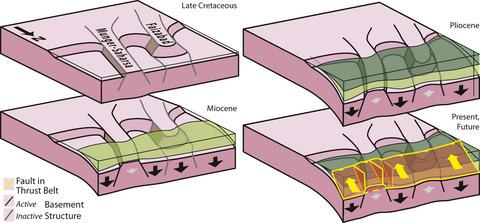当前位置:
X-MOL 学术
›
Basin Res.
›
论文详情
Our official English website, www.x-mol.net, welcomes your
feedback! (Note: you will need to create a separate account there.)
Indian plate structural inheritance in the Himalayan foreland basin, Nepal
Basin Research ( IF 2.8 ) Pub Date : 2021-07-15 , DOI: 10.1111/bre.12584 Michael J. Duvall 1 , John W.F. Waldron 1 , Laurent Godin 2 , Yani Najman 3 , Alex Copley 4
Basin Research ( IF 2.8 ) Pub Date : 2021-07-15 , DOI: 10.1111/bre.12584 Michael J. Duvall 1 , John W.F. Waldron 1 , Laurent Godin 2 , Yani Najman 3 , Alex Copley 4
Affiliation

|
The Himalaya, the Earth's largest active orogen, produces a deep but relatively unexplored foreland basin by loading the Indian Plate. Newly available two-dimensional seismic data (ca. 5,180 line km) spanning 900 km of the Nepali lowlands allow mapping and interpretation of several regional subsurface markers in two-way-travel time and estimated depth. Isopach maps for the major intervals allow us to interpret the interplay between basement structure, flexure, and faulting within the Ganga Basin. The Indian continental lithosphere beneath the foreland basin contains basement ridges oriented at high angles to the thrust belt. These basement structural highs and intervening depressions, tens to hundreds of kilometres wide, influenced deposition of the Precambrian Vindhyan strata and overlying Paleozoic to Mesozoic successions. The overlying Miocene to Quaternary foreland basin shows along-strike thickness variations across the basement features. Because the foreland basin sediments were mainly deposited in an alluvial plain close to sea-level, accommodation, and therefore thickness, was predominantly controlled by subsidence of the Indian Plate, providing evidence that the basement features controlled foreland basin development. Subsidence varied in time and space during Neogene basin development. When combined with flexural modelling, these observations imply that the subsidence history of the basin was controlled by inherited lateral variations in the flexural rigidity of the Indian Plate, as it was translated northward beneath the Himalayan Orogen. Basement features continue to play a role in higher levels of the thrust belt, showing that basement features in a down-going plate may produce non-cylindrical structures throughout orogen development.
中文翻译:

尼泊尔喜马拉雅前陆盆地印度板块构造继承
喜马拉雅山是地球上最大的活动造山带,它通过加载印度板块产生了一个较深但相对未开发的前陆盆地。跨越 900 公里尼泊尔低地的新二维地震数据(约 5,180 公里)允许在双向旅行时间和估计深度上绘制和解释几个区域地下标记。主要层段的等厚线图使我们能够解释恒河盆地内基底结构、弯曲和断层之间的相互作用。前陆盆地下方的印度大陆岩石圈包含与冲断带成大角度的基底脊。这些基底构造高点和中间凹陷,宽数十至数百公里,影响了前寒武纪温德地层和上覆古生代至中生代序列的沉积。上覆的中新世至第四纪前陆盆地显示出整个基底特征沿走向的厚度变化。由于前陆盆地沉积物主要沉积在靠近海平面的冲积平原上,因此容纳和厚度主要受印度板块下沉的控制,这提供了基底特征控制前陆盆地发育的证据。新近系盆地发育过程中沉降在时间和空间上的变化。当结合弯曲建模时,这些观察结果意味着盆地的下沉历史是由印度板块弯曲刚度的继承横向变化控制的,因为它在喜马拉雅造山带下方向北平移。基底特征继续在推力带的更高水平发挥作用,
更新日期:2021-09-03
中文翻译:

尼泊尔喜马拉雅前陆盆地印度板块构造继承
喜马拉雅山是地球上最大的活动造山带,它通过加载印度板块产生了一个较深但相对未开发的前陆盆地。跨越 900 公里尼泊尔低地的新二维地震数据(约 5,180 公里)允许在双向旅行时间和估计深度上绘制和解释几个区域地下标记。主要层段的等厚线图使我们能够解释恒河盆地内基底结构、弯曲和断层之间的相互作用。前陆盆地下方的印度大陆岩石圈包含与冲断带成大角度的基底脊。这些基底构造高点和中间凹陷,宽数十至数百公里,影响了前寒武纪温德地层和上覆古生代至中生代序列的沉积。上覆的中新世至第四纪前陆盆地显示出整个基底特征沿走向的厚度变化。由于前陆盆地沉积物主要沉积在靠近海平面的冲积平原上,因此容纳和厚度主要受印度板块下沉的控制,这提供了基底特征控制前陆盆地发育的证据。新近系盆地发育过程中沉降在时间和空间上的变化。当结合弯曲建模时,这些观察结果意味着盆地的下沉历史是由印度板块弯曲刚度的继承横向变化控制的,因为它在喜马拉雅造山带下方向北平移。基底特征继续在推力带的更高水平发挥作用,











































 京公网安备 11010802027423号
京公网安备 11010802027423号